ARTICLE

A masterpiece of design, engineering and decoration in Cambodia: Hindu epic stories, dancing, sunrises and several strange analogies.
- What is Angkor?
- Angkor Wat
- Astronomic and astrological analogies
- Cosmologic analogies
- Analogy of the Earth
- Analogy of life
- Analogy of elementals
I. What is Angkor?
Angkor is one of the world's seven wonders, an ancient conglomerate of temples meant to worship Hindu gods although it turned to Buddhism at the end of the XIIIth c. Two centuries later, the locations were abandoned due to war circumstances, whereas in 1992 one of the main temples (Angkor Wat) was included in Unesco's World Heritage List.
Angkor was the capital city of the ancient Khmer Empire all along Southeast Asia. The city was in the Northwest area of Cambodia nowadays, and was built around Phnom Bakheng, a temple settled down on a hill representing Mount Meru, the sacred mountain which is believed to be at the centre of the Universe, according to Hindu manuscripts.
Each king of the Empire extended the city and built more temples devoted to different deities, with big water reservoirs symbolizing the oceans that surround the sacred mountain in Hindu cosmology.
So Angkor became a group of temples over more than 248 miles, including more than 1000 buildings now located in the middle of the jungle. The main groups of temples are Angkor Thom, Ta Prom and Angkor Wat (the latter of a colossal size).

II. Angkor Wat
"Angkor" means "capital" and "wat" is translated as "temple". The construction was built in only 37 years (from 1113 to 1150), during Suryavarman II's rulership, a name translated as "protected by the sun". This is related to the fact that the temple was meant to worship Vishnu, being the Sun itself one of his avatars.
The main access is on the West side, from where one of the main attractions can be appreciated: the famous sunrises when the star seems to emerge from the central tower, during equinoxes.


Based on sandstones and laterite material (a type of brick easy to handle), of Hindu design, it can be considered as a mandala whose dimensions clearly refer to yugas.
The place includes courtyards inside of concentric walls, with a pit built for defensive purposes and water supply. In the middle, a 213 ft high tower is surrounded by other conic towers, shaped like lotus leaves, oriented towards the four cardinal directions, and representing Mount Meru's hills. The 5 towers can also be considered as a single group, with one of them in the centre and surrounded by the other four ones.
The walls in the courtyards include galleries with low-reliefs. The gallery on the external wall displays the greatest worldwide low-relief, divided into 8 sections (2 by side). And each section tells of an episode of the Ramayana or the Mahabharata, starting with the famous battle of Kurukshetra to the East of the access.

The gallery in the intermmediate wall displays a set of more than 1500 apsaras, experts in one of the most famous, elegant and refined dancing ever known, which is another classic attraction of the complex.
On the internal wall, there are reliefs of devatas. Both goddesses and apsaras are represented each one of them with single characteristics in heads, hands and feet:

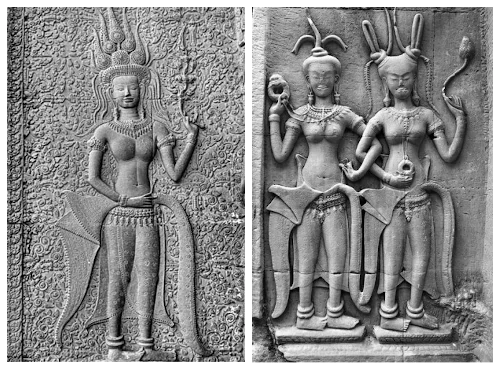
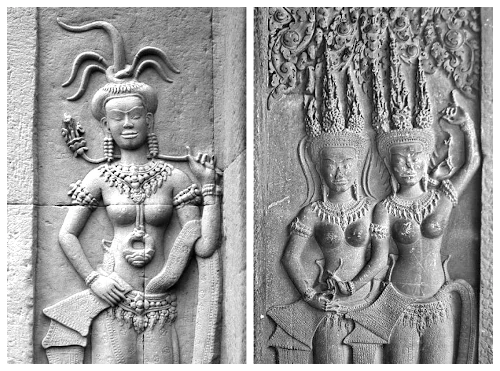

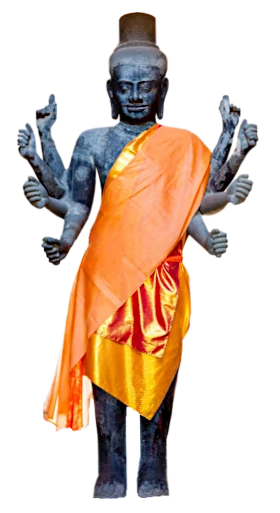
III. Astronomic & astrological analogies
The temple was constructed based on the elbow, an anthropomorphic measurement unit that counts the distance from the elbow to the end of an open hand or a closed fist. It can be appreciated in the dimensions of the temple's axes (related to the Sun's cycles) and perimeters (related to Moon's cycles). For example, the length of the outer wall is related to the duration of a solar cycle (the axis equals 365,24 elbows x 12, or 1 cycle of Jupiter). And the circumference of the wall equals 354,36 elbows x 24 (an annual lunar cycle during 5 Jupiter cycles, approx. 60 years).
On the other hand, the access allows the observation of synodic lunar months (29,53) as well as the total number of days with lunar visibility (28, like nakshatras or lunar mansions in Vedic Astrology).
The famous sunrises at the central tower can be appreciated from a long distance, more precisely by standing on the first staircase at the access. The view is like Vishnu emerging from inside of the tower and reaching the top.
Khmer people considered a new year began after three days since the Spring equinox, when the Sun can be seen rising up again over the same place, although from a few feet to South from the previous point of observation.
indexIV. Cosmologic analogies
The dimensions increase progressively in size, from the central galleries towards the periphery, which resembles the 8 concentric continents beneath Mount Meru, as they were separated by concentric oceans too, doubling each the width of the previous one.
Among the 8 narrations represented on the outer wall, one of them refers to the churning of the milky ocean, a famous episode that took place in the sixth ocean in between the continents.
The story tells that the devas were looking for amrita, a nectar providing immortality, which was the way to put an end to a curse casted on them. Devas and asuras (demons) pulled alternately from the extremes of Vasuki, a serpent used like a rope, who surrounded Mount Mandara. The Devas pulled from its tail and the asuras from the two heads of the animal, creating a kind of a churning move from which a lot of things later emerged: the apsaras, Moon and Lakshmi, among others.

V. Analogy of the Earth
The narration tells Mount Mandara emerged from the ocean (Milky Way) and was placed to the East of Mount Meru, to provide a base to make turning moves during the episode. There may be an analogy here, since Angkor Wat is located to the East of Phnom Bakheng (Mount Meru), so it might represent Mount Mandara. As the view is turned, the mentioned Western access would be located now at the South, so the sunrises would be seen at the new North direction (East).
Vasuki in Mount Mandara (the temple itself) also symbolizes the Earth's axis, with devas and asuras placed at the North and South poles, respectively. Even the narrations of the most outer wall are part of a sequence to be read counter-clockwise (starting from the battle of Kurukshetra), such as the Earth's motion across the orbital translation.
indexVI. Analogy of life
Nowadays and strangely, it's hard to find info on the internet about the most important and famous characteristic of the temple: it was entirely decorated with jewels, which turned the place into a without-equal show of natural lights, reflexes, energy and constant motion.
The sunlight was not just reflected on and from each tower in the main cardinal directions but also remained inside of stones, which made the structure shine at any moment and time of the year, without seasonal shadows, thus annulling the variations produced by day-night alternation.
If any temporary fluctuation, it might have been that of each special interaction of light, heat and energy when sunrays entered the stones from a different position every day, as the Sun moves during the year.
Other interactions were created in and from the very stones according to their different types, sizes and distribution. So each one of the gallery's reliefs was constantly illuminated by different colors and intensities, displaying each day a different show from the previous one.
By the Sun, Vishnu’s avatar, the jewels in Mount Mandara were constantly vitalized. And, because of the cardinal distribution, they turned the temple (Earth) into a place where light, motion and life were flowing all over the year, being the central tower the main focus of all the activity. The centre might have been the place receiving the greatest effects of all of the interactions, which were mainly turning effects, like the "blender" effect after the pullings of devas and asuras of Vasuki's body, and like the Earth turns around its own axis.
indexVII. Analogy of elementals
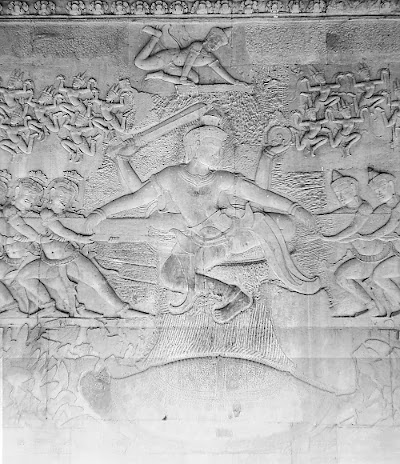
During the churning episode, Vishnu's second avatar (Kurma turtle, who lives at the bottom of the ocean) was placed under Mount Mandara to prevent it from sinking during the churning moves. This characteristic of the narration reminds of the base of Angkor's building: it's been constructed on an ancient hydraulic system meant to stabilize the base.
The foundations of the temples lay over a sand soil that could turn unstable during monsoons time, when the dry season contracts the soil. But water supplies remain stable over the year because the underwater supply is at a constant level. This is possible due to a hydraulic system designed to prevent the effects of dry seasons. There're pools, channels, barays (water storage tanks), pits, bridges and dykes based on the water's flow direction across the area, to guarantee irrigation and supplying. The great lake in the perimeter never gets completely dry, the fluctuations produced by the seasons don't change the soil, the foundations don't sink, and the structures don't collapse. This is another characteristic emphazising the meaning of vitality of Angkor Wat, or Vishnu's temple.
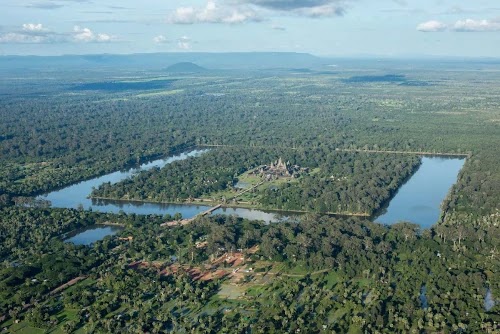
The light fluctuations produced by days and nights didn't change the conditions inside of the place since the reflexes of gems provided a high level of caloric energy. Anyway, the temple in a way shows that some fluctuations must continue for life going on: those of Mount Mandara itself (Earth), which provides water and air.
Natural elements must be transformed for water flows to be poured from the top of the mountains, which happens because the Earth rotates around its own axis thus impulsing water courses to be transformed into air. Later, precipitations give back water.
All of these characteristics reminds of Kurma, the turtle of stability in the epic narration, who supports the structure by stabilizing the flow, as elements are mixed, transformed and changed, to finally emerge from the "blender". For life to be, the Earth must turn. With water and air flows, the praised nectar or amrita emerges, the immortality that devas won at the end of the narration of the churning of the milky ocean.
indexSources: Templos de Angkor, 10 curiosidades sobre los templos de Angkor Wat, Angkor y la crisis del agua, Web Archive.





Comments
Join and leave a message. I always answer personally, and as soon as possible.